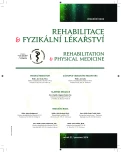Paresis of Nervus Thoracicus Longus after Resection of the Right Rib in the Thoracic Outlet Syndrome
Authors:
R. Bednár; G. Majeríková
Authors‘ workplace:
Odd. FBLR, FNsP, F. D. Roosevelta, Banská Bystrica, primár MUDr. G. Majeríková
Published in:
Rehabil. fyz. Lék., 21, 2014, No. 4, pp. 200-204.
Category:
Case Report
Overview
According to Woody the paresis of n. thoracicus longus after resection of the right rib from the transaxillar approach in cases of thoracic outlet syndrome is the second most frequent complication (8). In our report we resent the case of a 32 years old woman with thoracic outlet syndrome on the right with subsequent thrombosis of v. subclavia, v. axillaris, and v. brachialis after mechanical thrombectomy and local thrombolysis, after introduction of endovascular stent into v. subclavia on the right and after transaxillar resection of the right rib on the right, where postoperative paresis of n. thoracicus longus developed on the right. After a complex rehabilitation therapy in the course of five months a complete adjustment of the paresis developed. In addition to the exercise directed to the activity of shoulder humeral muscles and scapula stabilization it is necessary to adjust correct breathing and side trunk stabilizers, which form punctum fixum for m. serratus anterior. The indispensable part of a complex therapy is electric stimulation of n. thoracicus longus. The aligning shoulder band proved to be useful during the treatment.
Keywords:
paresis of n. thoracicus longus, resection of the right rib in thoracic outlet syndrome, m. serratus anterior, rehabilitation of n. thoracicus longus paresis
Sources
1. GÚTH, A., MIKUŠOVÁ, E., PALÁT, M.: Paresis nervi thoracici longi (nervi belli). Rehabilitácia, roč. 14, 1981, č. 1, s. 25-28.
2. HESTER, P., CABORN, M., N., D., NYLAND, J. at al.: Cause of long thoracic nerve palsy: A possible dynamic fascial sling cause. J. Shoulder Elbow Surg., roč. 9, 2000, č. 1, s. 31-35.
3. KOLÁŘ, P. et al.: Rehabilitace v klinické praxi. 1. vyd., Praha, Galén, 2009, s. 238.
4. KOLÁŘ, P. et al.: Rehabilitace v klinické praxi. 1. vyd., Praha, Galén, 2009, s. 336.
5. NAKATSUCHI, Y., SAITAH, S., HOSAKA, M. et al.: Long thoracic nerve paralysis associated wth thoracic outlet syndrome. J. Shoulder Elbow Surg.. roč. 3, 1994, s. 28-33.
6. VÉLE, F.: Kineziologie: Přehled klinické kineziologie a patokineziologie pro diagnostiku a terapii poruch pohybové soustavy. 2. přeprac. vyd., Praha, TRITON, 2006. s. 268.
7. WARNER, J. P. J., NAVARRO, R. A.: Searratus anterior dysfunction: Recognition and treatment. Clin. Orthop. Relat. Res., 1998, č. 349, s. 139-148.
8. WOOD, V. E., FRYKMAN, G. K.: Winging of sacapula as a complication of first rib resection: Report of six cases. Clin. Orthop. Relat. Res., 1980, č. 149, s. 160-163.
Labels
Physiotherapist, university degree Rehabilitation Sports medicineArticle was published in
Rehabilitation & Physical Medicine

2014 Issue 4
- Hope Awakens with Early Diagnosis of Parkinson's Disease Based on Skin Odor
- Deep stimulation of the globus pallidus improved clinical symptoms in a patient with refractory parkinsonism and genetic mutation
Most read in this issue
- Shoulder in Epitome – Second Part
- Concept of Castillo Morales® v Theory and Practice
- Paresis of Nervus Thoracicus Longus after Resection of the Right Rib in the Thoracic Outlet Syndrome
- Czech Version of the Neck Disability Index and its Application in Patients with Neck Pain
